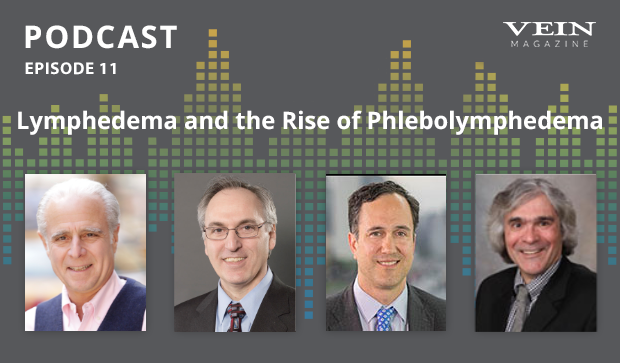
Welcome to the VEIN Magazine podcast with Dr. Steve Elias, where vein specialists sit around, having drinks and talking.
In this episode, Steve is joined by vascular specialists Dr. Thomas Maldonado from NYU Langone Medical Center, Dr. Peter Pappas from Center for Vein Restoration, and Dr. Thom Rooke from the Mayo Clinic to discuss the modern management of lymphedema and the emerging concept of phlebolymphedema.
Special Thanks to our Sponsor
This episode was made possible with support from Tactile Medical, maker of the Flexitouch, an advanced intermittent pneumatic compression device (lymphedema pump) used by tens of thousands of patients to self-manage lymphedema and non-healing venous leg ulcers. Learn more about the Flexitouch system at https://www.tactilemedical.com/

Subscribe to the VEIN Magazine podcast on iTunes, Apple Podcast, or wherever you listen to podcasts.
Episode Summary
Lymphedema, swelling caused by a lymphatic system blockage, was once an elusive disease. This June, as Thomas, Peter, and Thom sit in a room at the Expert Venous Management (EVF) Conference and Expo in Englewood, NJ, they reflect back on their years of practice and remember a time when patients would show up not knowing what lymphedema was.
Today, the trio approximates just more than half are still in the dark; there are more now who are using the term "lymphedema" and asking questions about how to effectively manage the condition.
“It used to be where no one would ever show up even knowing what lymphedema is," said Thom. "I'm surprised that more and more patients are hearing the word and coming in."
Yet, they're quick to recognize another group of patients is rising, and it's giving way to a budding concept called phlebolymphedema, where the patient experiences swelling but it's not characterized.
"It's venous swelling that goes into lymphatic disease," said Thomas. "They don't necessarily have a diagnosis of lymphedema, but they have venous disease leading to swelling and a compromised lymphatic system." Often in these cases, it can be treated or intervened for.
The challenge for patients and some doctors they've seen in the past for help is receiving an accurate diagnosis and resulting treatment plan. When a patient has early lymphedema, the signs and symptoms "looks like everything else," Thom noted. It could be venous in nature, lymphatic, or due to other causes such as cardiovascular or renal disease.
Steve asks Thom to detail how he makes the distinction, particularly as it relates to patients with unilateral leg swelling. His summed response is testing, physical exam, and more importantly vascular experience.
Two tale-tell signs are the absence of obvious venous disease and vein restriction.
"I do think that 90-95% of the time, unilateral swelling is either going to be venous or lymphatic disease; there are only a few other exceptions," he remarks. "People with lymphedema, especially the primary type and some triggered secondary types, typically have no signs of venous abnormalities. It's extremely common for them to not just have no varicose veins but small veins on the affected limb and everywhere else."
If lymphedema has advanced, it was added, there is an inability to pinch the skin and the nails, if yellow or infected, give a clue.
Peter chimed that a buffalo hump or stemmer sign on the foot are great indicators, but that something can also be said about patient history. A classic sign of lymphedema in female teens, as an example, is unilateral swelling that coincides with the beginning of their menstrual cycle. For middle-aged and older adults, an event or action has led to it.
"There is a lot you can get from their history if you just listen to what they're saying."
Yet, listening is for gathering evidence and speaking is for improving patient quality of life.
After making a diagnosis, Thomas spends most of his time educating patients and giving them hope after a long journey of "doctor shopping and looking for answers." Many, he said, have their hope restored when they realize there are things they can do themselves at home, like physical therapy and pneumatic compression. "It empowers the patient quite a bit."
With the patient an active participant in their daily care, they are in a far greater position to manage their swelling and get back to living.
To hear more about lymphedema management and how phlebolymphedema is taking shape, as well as being tackled, listen to the full podcast.
Thank you for joining us. We'd love to hear your thoughts on this episode of the VEIN Podcast. Leave a comment below and subscribe to the VEIN Magazine podcast on iTunes, or wherever you get your podcasts.


